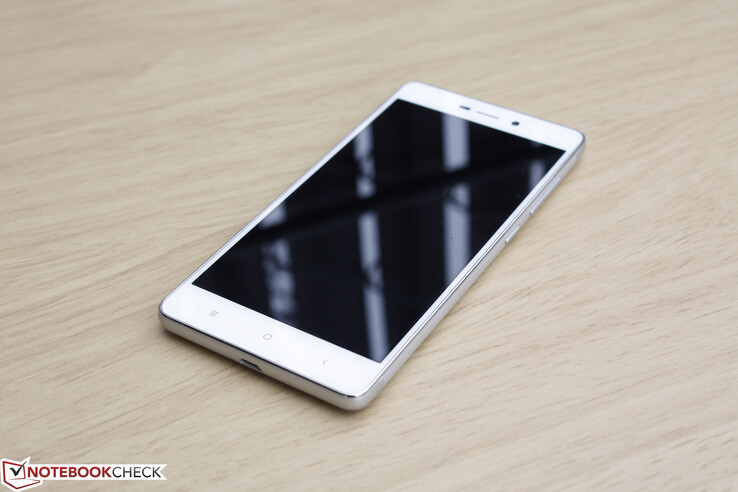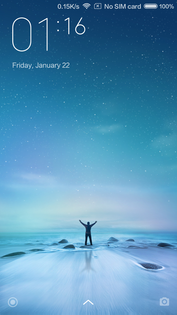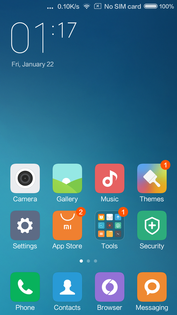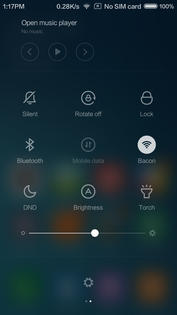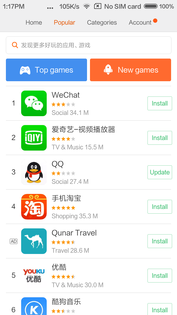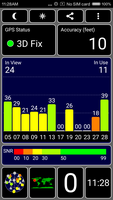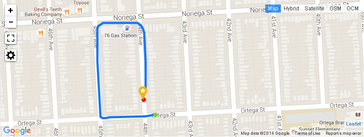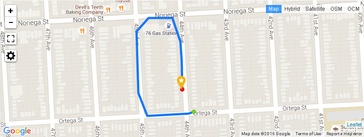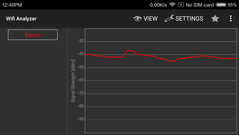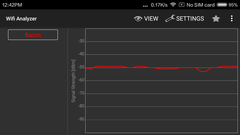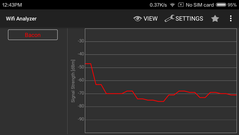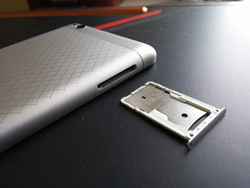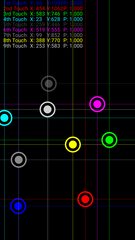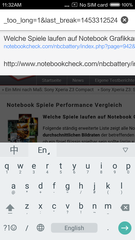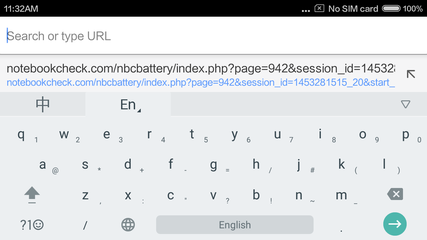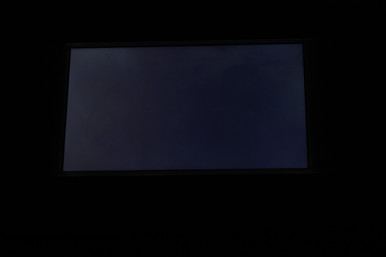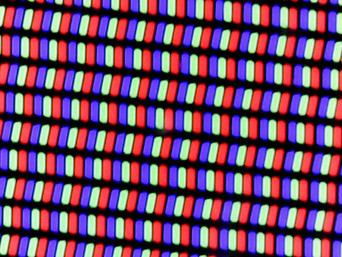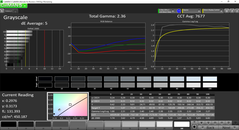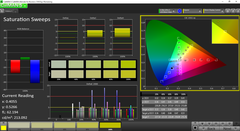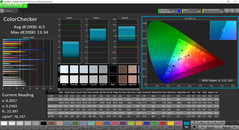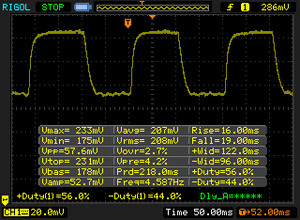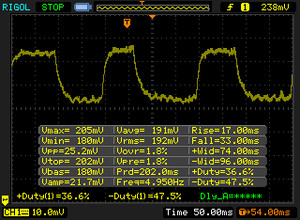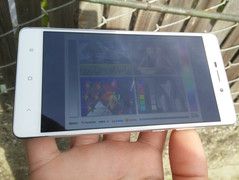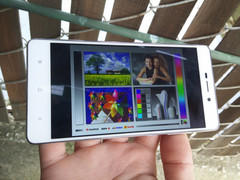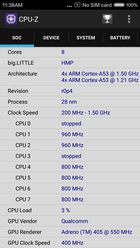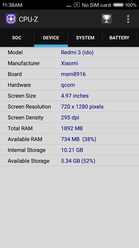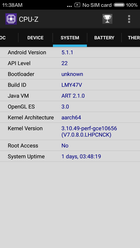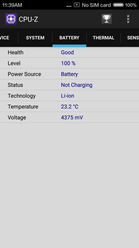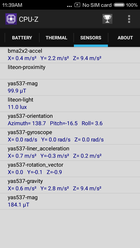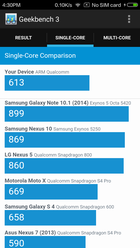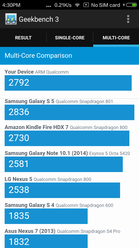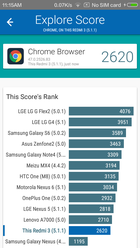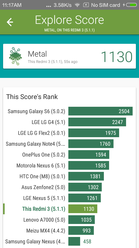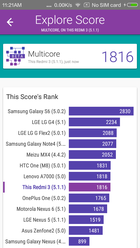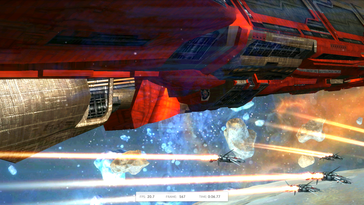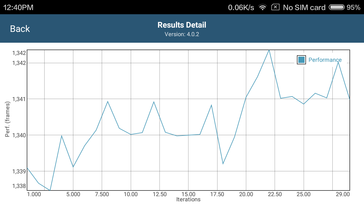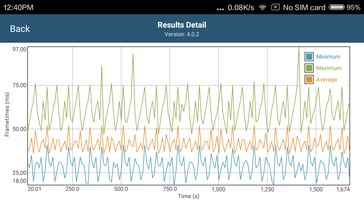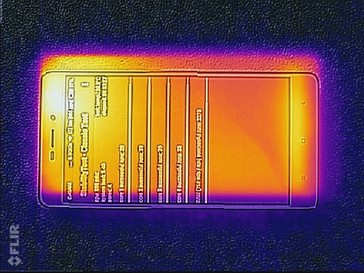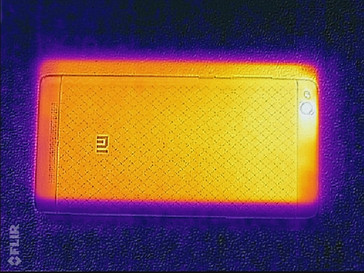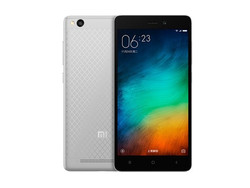Xiaomi Redmi 3 Smartphone Review

Xiaomi is one of the more well-known manufacturers from China having recently surpassed Lenovo in worldwide market share as of 2015. Like Huawei, its brand and Redmi series are starting to become household names overseas.
The latest inexpensive model for the Redmi series is the Redmi 3 with the brand new octa-core Snapdragon 616 SoC. Compared to the Redmi 2, this third generation model carries a larger display and a slightly larger footprint as a result. Is this a step forward from last year's offering?
Case
In terms of looks and feel, the Redmi 3 already surpasses its predecessor. The cheap plastic feel of the Redmi 2 is now a matte silvery surface with a printed diamond pattern and chrome lining around the front edges and corners. It's still a smooth surface from top to bottom not unlike on an iPhone, so Xiaomi has gone for a higher-end feel without necessarily jacking up prices.
Case quality is very good with only very minimal twisting and slight creaking when attempting to bend the device. Pressing down firmly on the glass display will cause ripples on the screen. Otherwise, the phone is well made with no unintended crevices in between edges. On the flip side, the back cover is no longer removable and the manufacturer offers only Silver, Gray, and Gold colors.
In terms of size, the Redmi 3 is almost a full millimeter thinner than the Redmi 2 whilst having a bigger display. It is also heavier (144 g vs. 133 g), longer, and wider, though still relatively small compared to other 5-inch smartphones like the HTC One M9 or Samsung Galaxy J5. The dimensions of the Xiaomi are very close to the OnePlus X, albeit noticeably thicker.
Connectivity
Available ports are the usual 3.5 mm audio and Micro-USB 2.0 with OTG support. The SIM trays and MicroSD slot are now accessible from the edge. While NFC or MHL are not available, there is an IR blaster on the top edge of the device for remote functionality.
Software
The MIUI 7 UI is based on Android 5.1 Lollipop and runs swiftly without any notable issues. There is the occasional stuttering when launching applications or when scrolling through the Home screen and dropdown menu, so performance is not entirely smooth. Fortunately, these are very short-lived and do not impact the usability of the phone.
Pre-installed applications include Mi Home, Mi App Store, Security Center, Mi Video Player, and others. The official Google Play Store must be installed manually via the Mi App Store and requires Developer Options to be enabled through the Settings.
Communication & GPS
WLAN is supported up to 802.11n with Wi-Fi Direct and hotspot options. We experienced no connectivity issues during our time with the test unit with signal quality similar to other mainstream smartphones at equivalent distances. Anything further than 20 m or 25 m will cause signal strength to drop to the uncomfortable -80 dBm range.
GPS, GLONASS, and BDS are supported on the Redmi 3. Our quick GPS test shows it to be less accurate than a dedicated Garmin 500 around corners. This makes the smartphone a poorer choice for off-road tracking and satisfactory for driving purposes.
Telephone & Voice Quality
Compatible networks include 2G GSM, 3G WCDMA, and 4G FDD-LTE on LTE bands 1(2100), 3(1800), 7(2600), 38(2600), 39(1900), 40(2300), 41(2500). The full specifications list can be found on the official Xiaomi page and buyers of any international smartphone should check that the bands are compatible with their major networks. In the U.S., we were able to make calls via the T-Mobile network and receive up to 3G data. Note that the MicroSD slot utilizes the same space as the second SIM slot on the removable tray, so users cannot use both simultaneously.
Call quality is very good from both sides with no major static or disruptions. Maximum volume is sufficiently loud through the earpiece.
Cameras & Multimedia
The rear 13 MP camera produces relatively good pictures when outdoors. We would have liked for the images to be a little brighter and the colors to be a bit cooler and more saturated, but the Redmi 3 compares quite well against even the LG G3 with no major hints of purple fringing around hairline edges or excessively muddy pixels when up close.
Video recording is supported up to 1080p30 with anti-jittering for smoother motion and panning. Quality is good overall for the price, albeit grainier and muddier than expected.
Input Devices
Touchscreen
The 10-point capacitive touchscreen is as accurate around the edges and corners as it is towards the center. Additionally, typing with the onscreen keyboard is swift and responsive enough for even fast typists. However, we found the display to be very sensitive on its default setting. For example, attempts at swiping or scrolling will sometimes register as a tap or click instead, which can be annoying on the Home screen where we simply wanted to scroll and not open an application. This occurs more often than on other Android smartphones.
Aside from the touchscreen, the Redmi 3 also uses three dedicated Android buttons on the bottom with no backlight lighting. The manufacturer is sticking to the layout on Samsung Galaxy models by having the Back key on the right side of the phone instead of the left.
Display
The 5-inch screen may not be 1080p, but don't let its 720p resolution fool you. Texts and images still appear crisp and very close to the surface for a better pop-up effect. The backlight in particular is very bright at almost 500 nits on average, which matches or exceeds a handful of other brand name 5-inch models. Contrast, colors, grayscale, and gamma are also measurable improvements over the Redmi 2.
There is some minor backlight bleeding nearest the left and right edges and the brightness distribution could have been better. Nonetheless, these negatives are very hard to notice during regular use and minor enough to not be of any distraction when watching videos.
| |||||||||||||||||||||||||
Brightness Distribution: 89 %
Center on Battery: 488.6 cd/m²
Contrast: 887:1 (Black: 0.551 cd/m²)
ΔE ColorChecker Calman: 6.5 | ∀{0.5-29.43 Ø4.79}
ΔE Greyscale Calman: 5 | ∀{0.09-98 Ø5}
Gamma: 2.36
CCT: 7677 K
| Xiaomi Redmi 3 5", 1280x720 | Xiaomi Redmi 2 4.7", 1280x720 | Google Nexus 5X 5.2", 1920x1080 | Asus Zenfone 2 ZE500KL 5", 1280x720 | HTC One M9 5", 1920x1080 | Microsoft Lumia 640 5", 1280x720 | OnePlus X 5", 1920x1080 | |
|---|---|---|---|---|---|---|---|
| Response Times | |||||||
| Response Time Grey 50% / Grey 80% * (ms) | 50 ? | ||||||
| Response Time Black / White * (ms) | 35 ? | ||||||
| PWM Frequency (Hz) | 237 ? | ||||||
| Screen | -20% | 32% | 33% | 4% | 10% | -26% | |
| Brightness middle (cd/m²) | 488.6 | 421.4 -14% | 503 3% | 467 -4% | 474 -3% | 433 -11% | 312 -36% |
| Brightness (cd/m²) | 484 | 429 -11% | 498 3% | 460 -5% | 458 -5% | 429 -11% | 314 -35% |
| Brightness Distribution (%) | 89 | 89 0% | 97 9% | 95 7% | 85 -4% | 95 7% | 91 2% |
| Black Level * (cd/m²) | 0.551 | 0.642 -17% | 0.38 31% | 0.3 46% | 0.4 27% | 0.52 6% | |
| Contrast (:1) | 887 | 656 -26% | 1324 49% | 1557 76% | 1185 34% | 833 -6% | |
| Colorchecker dE 2000 * | 6.5 | 7.31 -12% | 2.09 68% | 3.28 50% | 6.32 3% | 3.42 47% | 6.28 3% |
| Greyscale dE 2000 * | 5 | 7.88 -58% | 2.12 58% | 1.89 62% | 6.36 -27% | 3.03 39% | 8.24 -65% |
| Gamma | 2.36 93% | 2.51 88% | 2.27 97% | 2.21 100% | 2.43 91% | 2.16 102% | 2.12 104% |
| CCT | 7677 85% | 8944 73% | 6621 98% | 6734 97% | 8218 79% | 7081 92% | 8145 80% |
| Color Space (Percent of AdobeRGB 1998) (%) | 58.81 | ||||||
| Total Average (Program / Settings) | -20% /
-20% | 32% /
32% | 33% /
33% | 4% /
4% | 10% /
10% | -26% /
-26% |
* ... smaller is better
While colors and grayscale have improved and are certainly better than many lesser-known Chinese smartphones in its price range, costlier and more popular 5-inch smartphones like the Nexus 5X or HTC One M9 still provide deeper blacks and generally more accurate displays. Blue colors in particular are less accurate than other colors on the Redmi 3 in intermediate saturation levels.
Display Response Times
| ↔ Response Time Black to White | ||
|---|---|---|
| 35 ms ... rise ↗ and fall ↘ combined | ↗ 16 ms rise | |
| ↘ 19 ms fall | ||
| The screen shows slow response rates in our tests and will be unsatisfactory for gamers. In comparison, all tested devices range from 0.1 (minimum) to 240 (maximum) ms. » 92 % of all devices are better. This means that the measured response time is worse than the average of all tested devices (20.3 ms). | ||
| ↔ Response Time 50% Grey to 80% Grey | ||
| 50 ms ... rise ↗ and fall ↘ combined | ↗ 17 ms rise | |
| ↘ 33 ms fall | ||
| The screen shows slow response rates in our tests and will be unsatisfactory for gamers. In comparison, all tested devices range from 0.165 (minimum) to 636 (maximum) ms. » 85 % of all devices are better. This means that the measured response time is worse than the average of all tested devices (31.7 ms). | ||
Screen Flickering / PWM (Pulse-Width Modulation)
| Screen flickering / PWM not detected | ||
In comparison: 53 % of all tested devices do not use PWM to dim the display. If PWM was detected, an average of 8152 (minimum: 5 - maximum: 343500) Hz was measured. | ||
Outdoor visibility is good due to the bright backlight. Content is easy to see and read when under shade or when reflections can be reduced. On the other hand, direct sunlight still proves to be too much for the Xiaomi to handle. The wide IPS viewing angles mean comfortable use in all orientations, which is especially helpful when attempting to avoid glare.
Performance
The Redmi 3 is one of the earliest smartphones to ship with the new Snapdragon 616 SoC. This mainstream octa-core SoC can run as low as 200 MHz or as high as 1.5 GHz according to CPU-Z. This maximum is only attainable on four of the Cortex-A53 cores as the other four are limited to 1.2 GHz in comparison. LPDDR3 RAM is available up to 2 GB.
Processor
Compared to the Snapdragon 410, the Snapdragon 616 offers 30 percent to 50 percent faster performance in single-threaded and multi-threaded processors, respectively, according to LinPack. Geekbench 3 ranks our Redmi 3 below the Nexus 5 (Snapdragon 800) in single-core performance and slightly above the Nexus 5 in multi-core performance. In essence, the Snapdragon 616 is roughly equivalent in raw performance to smartphones sporting the Snapdragon 800 or 801.
More recent flagship processors like the Exynos 7420 Octa or Snapdragon 810 will still handily outclass the Snapdragon 616 according to LinPack and AnTuTu v6.
| PCMark for Android - Work performance score (sort by value) | |
| Xiaomi Redmi 3 | |
| Samsung Galaxy S6 Edge | |
| Medion Life X5020 | |
| Google Nexus 6P | |
| Google Nexus 5X | |
| Motorola Moto G 3. Gen 2015 XT1541 | |
| AnTuTu v6 - Total Score (sort by value) | |
| Xiaomi Redmi 3 | |
| Google Nexus 6P | |
| Geekbench 3 | |
| 32 Bit Multi-Core Score (sort by value) | |
| Samsung Galaxy S6 Edge | |
| Motorola Moto G 3. Gen 2015 XT1541 | |
| 32 Bit Single-Core Score (sort by value) | |
| Samsung Galaxy S6 Edge | |
| Motorola Moto G 3. Gen 2015 XT1541 | |
| 64 Bit Multi-Core Score (sort by value) | |
| Xiaomi Redmi 3 | |
| Samsung Galaxy S6 Edge | |
| Medion Life X5020 | |
| Google Nexus 6P | |
| Google Nexus 5X | |
| Motorola Moto G 3. Gen 2015 XT1541 | |
| 64 Bit Single-Core Score (sort by value) | |
| Xiaomi Redmi 3 | |
| Samsung Galaxy S6 Edge | |
| Medion Life X5020 | |
| Google Nexus 6P | |
| Google Nexus 5X | |
| Motorola Moto G 3. Gen 2015 XT1541 | |
| Google V8 Ver. 7 - Google V8 Ver. 7 Score (sort by value) | |
| Xiaomi Redmi 3 | |
| Samsung Galaxy S6 Edge | |
| Medion Life X5020 | |
| Google Nexus 6P | |
| Google Nexus 5X | |
| Motorola Moto G 3. Gen 2015 XT1541 | |
| Browsermark - 2.1 (sort by value) | |
| Xiaomi Redmi 3 | |
| Samsung Galaxy S6 Edge | |
| Motorola Moto G 3. Gen 2015 XT1541 | |
| Sunspider | |
| 1.0 Total Score (sort by value) | |
| Xiaomi Redmi 3 | |
| Samsung Galaxy S6 Edge | |
| Medion Life X5020 | |
| Google Nexus 6P | |
| Google Nexus 5X | |
| Motorola Moto G 3. Gen 2015 XT1541 | |
| 0.9.1 Total Score (sort by value) | |
| Xiaomi Redmi 3 | |
| JetStream 1.1 - Total Score (sort by value) | |
| Xiaomi Redmi 3 | |
| Samsung Galaxy S6 Edge | |
| Medion Life X5020 | |
| Google Nexus 6P | |
| Google Nexus 5X | |
| Motorola Moto G 3. Gen 2015 XT1541 | |
| Mozilla Kraken 1.1 - Total (sort by value) | |
| Xiaomi Redmi 3 | |
| Samsung Galaxy S6 Edge | |
| Medion Life X5020 | |
| Google Nexus 6P | |
| Google Nexus 5X | |
| Motorola Moto G 3. Gen 2015 XT1541 | |
| Octane V2 - Total Score (sort by value) | |
| Xiaomi Redmi 3 | |
| Samsung Galaxy S6 Edge | |
| Medion Life X5020 | |
| Google Nexus 6P | |
| Google Nexus 5X | |
| Motorola Moto G 3. Gen 2015 XT1541 | |
| WebXPRT 2015 - Overall (sort by value) | |
| Xiaomi Redmi 3 | |
| Medion Life X5020 | |
| Google Nexus 6P | |
| Google Nexus 5X | |
| Motorola Moto G 3. Gen 2015 XT1541 | |
| Quadrant Standard Edition 2.0 - --- (sort by value) | |
| Xiaomi Redmi 3 | |
| Samsung Galaxy S6 Edge | |
| Motorola Moto G 3. Gen 2015 XT1541 | |
| Motorola Moto G 3. Gen 2015 XT1541 | |
* ... smaller is better
Storage Devices
The internal 16 GB eMMC offers about 11 GB of free space for the end-user. Transfer rates are almost identical to that of the Redmi 2, so Xiaomi likely decided that any major improvements in this area were not needed. The Nexus 5X and flagship Galaxy S6 Edge Plus both offer consistently faster transfer rates than our Redmi 3 test unit. MicroSD cards are supported up to 128 GB.
GPU Performance
The integrated Adreno 405 pumps out double the performance of the Redmi 2 when running the Epic Citadel benchmark on Ultra High quality (30.3 FPS vs. 59.0 FPS). Lightmark, which is notorious for its very demanding benchmark scene, averages over three times the frame rates of the Adreno 306 in the Snapdragon 410 SoC. The latest titles off of the Android Market run very smoothly and without notable hitches on the native 720p resolution of the Redmi 3.
No major throttling occurs after running the GFXBench battery test on a loop for half an hour. Frame times and performance remain steady throughout the entire run. Note that core temperatures can reach up to 55 - 60 C when under such intensive conditions according to CPU-Z.
| Lightmark - 1920x1080 1080p (sort by value) | |
| Xiaomi Redmi 3 | |
| Sony Xperia Z5 Premium | |
| Samsung Galaxy Note 5 SM-N920A | |
| Motorola Moto X Play | |
| Motorola Moto G 3. Gen 2015 XT1541 | |
Emissions
Temperature
Qualcomm was probably unhappy about the press overplaying the overheating and throttling issues facing certain flagship Snapdragon SoCs. When under unrealistic maximum loads for over an hour, we were able to record a surface temperature of just under 44 C nearest the top corner where the mainboard is likely located. This area also happens to be very close to the earpiece, so attempting to make calls right after browsing or playing games will make for a very warm ear.
Compared to the Nexus 5X and HTC One M9, the Redmi 3 does indeed have a higher maximum surface temperature even with the newer generation Snapdragon 616 SoC. When compared to the Redmi 2, however, average temperatures are still lower despite being much more powerful. The OnePlus X and its Snapdragon 801 is even warmer still surface temperatures averaging 40 C when under maximum load.
(±) The maximum temperature on the upper side is 43.6 °C / 110 F, compared to the average of 35.2 °C / 95 F, ranging from 21.9 to 247 °C for the class Smartphone.
(+) The bottom heats up to a maximum of 37.6 °C / 100 F, compared to the average of 34 °C / 93 F
(+) In idle usage, the average temperature for the upper side is 21.9 °C / 71 F, compared to the device average of 32.9 °C / 91 F.
Speakers
The rear speakerphone produces clear sounds with limited bass and range. Maximum volume is sufficiently loud, though distortions become more obvious at such high volume settings. The positioning of the speaker makes the grilles too easy to cover up whilst holding onto the phone in either orientation, so music and voices are almost always slightly muffled.
Battery Life
As a trade off for the now non-removable back cover, Xiaomi has equipped the Redmi 3 with a dense 4100 mAh battery. This is an unusually high capacity especially for a budget smartphone where the low-to-mid 2000 mAh range is much more common.
The combination of a new power-efficient Snapdragon SoC, dense battery, and "standard" resolution 720p screen has created extraordinarily long runtimes. Users can expect 13 hours of constant WLAN use and at least five hours of very heavy use at maximum brightness. Competing smartphones will last for hours less in comparison.
| Xiaomi Redmi 3 4100 mAh | Xiaomi Redmi 2 2200 mAh | Google Nexus 5X 2700 mAh | Asus Zenfone 2 ZE500KL 2070 mAh | HTC One M9 2840 mAh | Microsoft Lumia 640 2500 mAh | OnePlus X 2525 mAh | |
|---|---|---|---|---|---|---|---|
| Battery runtime | -47% | -31% | -65% | -48% | -45% | -25% | |
| Reader / Idle (h) | 41.4 | 17.7 -57% | 29.6 -29% | 13.4 -68% | 18 -57% | 16.1 -61% | |
| WiFi v1.3 (h) | 13 | 5.9 -55% | 6.9 -47% | 4.5 -65% | 5.8 -55% | 8.4 -35% | 9.2 -29% |
| Load (h) | 5 | 3.6 -28% | 4.1 -18% | 3.9 -22% | 2.8 -44% | 5.7 14% | |
| WiFi (h) | 9.6 |
Pros
Cons
Verdict
Inexpensive Chinese smartphones have been more difficult to recommend in the past, but major manufacturers like Huawei and Xiaomi are proving quite quickly that users don't need to spend anything more than $200 or $300 USD for a brand new and perfectly reliable smartphone. The Redmi 3 feels less like a toy and more of a professional mainstream offering without skimping on any key areas like display quality, build quality, or battery life. In fact, the Xiaomi actually excels in a few categories including its exceptionally bright backlight and long runtimes.
As for the hardware inside, you'd be hard pressed to find a smartphone this early in the year with both 2 GB RAM and a Snapdragon 616 SoC for less than $160. We're a bit disappointed by the lack of a 1080p, NFC, USB Type-C, and a removable back cover, but it is otherwise a worthwhile successor to the Redmi 2 in every way.
Xiaomi is kicking off the new year with one of its best mainstream offerings to date with the Redmi 3. Its backlight and battery life are exceptional even when compared to smartphones beyond its budget price range.
Xiaomi Redmi 3
- 01/23/2016 v4.1 (old)
Allen Ngo




